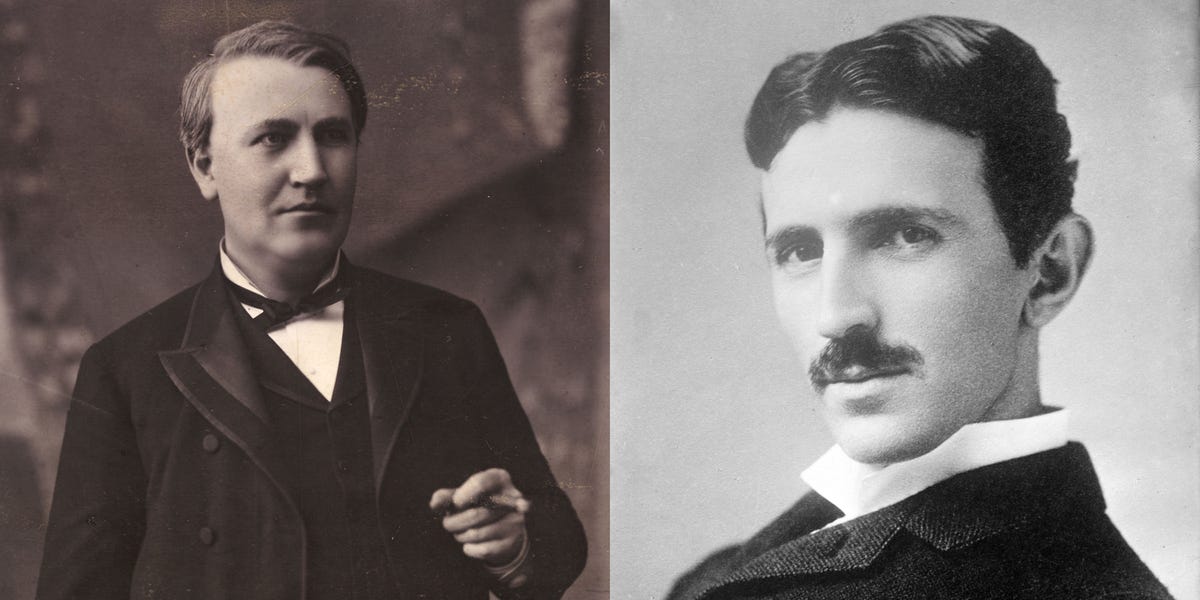The history of electricity is a fascinating tale of innovation, rivalry, and ultimately, triumph. At the heart of this story lies The “war Of Currents,” a battle waged between two titans of invention: Thomas Edison and Nikola Tesla. While both men sought to illuminate the world with their groundbreaking ideas, Their Approaches Differed Dramatically, leading to a clash that would shape the future of power generation As We Know It.
Edison’S Direct Current (Dc) system, initially safer than the existing arc lamps, Quickly Gained Popularity. However, Dc had limitations. It could only travel short distances efficiently before significant power loss occurred. This meant that generating stations needed to be located close to consumers, Restricting Widespread Adoption. Enter Nikola Tesla, a brilliant Serbian-American inventor who saw the potential of alternating current (Ac). Ac, unlike Dc, could be transmitted over long distances with minimal energy loss, paving the way for a truly Interconnected Electrical Grid.
Tesla’s vision was revolutionary, and he developed a highly efficient Ac generator system. Seeing its potential, George Westinghouse, Edison’S Rival, licensed Tesla’s technology. This move ignited The “war Of Currents,” as Edison, fiercely protective of his Dc monopoly, employed tactics to discredit Ac, even resorting to sensationalized demonstrations highlighting Its Perceived Dangers.
Direct Current Dominance
At the turn of the 20th century, Thomas Edison’s Direct Current (Dc) System Reigned Supreme. Edison had successfully marketed his incandescent Light Bulbs, creating a demand for reliable electrical power. His Dc system, while initially safer than the flickering arc lamps that preceded it, was well-suited for smaller applications like lighting individual homes and businesses.
The limitations of Dc became apparent as cities expanded and the need for long-Distance Power Transmission Arose. Edison’s system struggled to deliver electricity Efficiently Over Greater Distances, resulting in significant power loss. This meant that generating stations had to be located close to consumers, hindering widespread adoption and limiting the potential of electricity to power entire industries.
 Inspirational Women: Famous Females Who Shaped History
Inspirational Women: Famous Females Who Shaped HistoryDespite these limitations, Edison‘s Dc system enjoyed a period of dominance. His reputation as a visionary inventor, coupled with aggressive marketing campaigns, convinced many that his system was the only viable option for electrical power. However, the tide was about to turn with the emergence of a revolutionary alternative: Alternating Current (AC).
The Rise Of Alternating Current
While Edison championed direct current (Dc), Nikola Tesla, a brilliant Serbian-American inventor, saw the potential of alternating current (Ac). Ac, unlike Dc, could be easily stepped up or down in voltage using transformers. This meant that electricity could be transmitted over long distances with minimal energy loss and then efficiently delivered to consumers at the appropriate voltage.
Tesla’s vision was revolutionary. He developed a highly efficient AC generator system and recognized its potential for widespread adoption. Seeing the value in Tesla’s invention, George Westinghouse, Edison’S Rival, licensed Tesla’s technology. This marked a turning point in The “war Of Currents,” as Westinghouse began to challenge Edison’s dominance with his AC-Powered Systems.
The advantages of Ac quickly became apparent. It allowed for long-Distance Transmission, making it ideal for powering entire cities and industries. As more people witnessed the benefits of Ac, Its Popularity Surged, paving the way for a new era of electrical power generation and distribution.
The War Of Currents Begins
The rivalry between Edison and Tesla escalated into a full-blown “War Of Currents” as Westinghouse embraced Ac and challenged Edison’s Dc monopoly. Edison, fiercely protective of his invention and Its Financial Success, resorted to increasingly aggressive tactics to discredit Ac. He spread misinformation about its safety, claiming it was more prone to electrocution, and even went so far as to publicly execute animals using Ac in a gruesome spectacle designed to frighten the public.
These sensationalized demonstrations, while effective in generating fear, were ultimately misleading. Ac, when properly installed and maintained, was no more dangerous than Dc. Edison’s campaign was driven by self-preservation, a desperate attempt to maintain his dominance in the face of a Superior Technology. Public opinion, initially swayed by Edison’s charisma and marketing prowess, began to shift as evidence of Ac’s efficiency and safety emerged.
The tide turned when Westinghouse successfully powered the 1893 World’s Columbian Exposition in Chicago with Ac. The dazzling display of electric lights and appliances captivated visitors and showcased the potential of Ac to illuminate the world. This victory marked a turning point in The “war Of Currents,” solidifying Ac as the superior technology and paving the way for its Widespread Adoption.
Tesla’s AC Triumph
The momentum shifted decisively in favor of Ac after the 1893 World’s Fair. Westinghouse’s successful demonstration of Ac-powered systems captivated the world and proved its capabilities for large-Scale Applications. This success, coupled with Edison’s increasingly desperate attempts to discredit Ac, eroded public confidence in Dc.
Tesla, meanwhile, continued to refine his Ac system and advocate for its widespread adoption. His vision of a future powered by efficient, long-distance transmission of electricity was finally Gaining Traction. As more cities and industries embraced Ac, The “war Of Currents” effectively ended with Tesla’s Technology Emerging Victorious.
The triumph of Ac marked a significant turning point in history. It enabled the electrification of entire nations, fueling industrial growth and transforming the Way We Live. Tesla’s legacy as the father of modern electrical power systems is undeniable, his vision for an interconnected world powered by efficient Ac ultimately prevailing over Edison’s Direct Current System.
Electrifying the World
The widespread adoption of alternating current ushered in a new era of progress and innovation. Cities around the world were electrified, transforming from dimly lit streets to bustling centers of activity illuminated by Electric Lights. Factories could now operate around the clock, powered by reliable electricity, leading to increased production and economic growth.
Homes were equipped with electrical appliances, changing daily life for millions. From washing machines and refrigerators to electric irons and vacuum cleaners, Ac power made everyday tasks easier and more efficient. The electrification of the world revolutionized Transportation As Well, with electric streetcars and trains becoming Increasingly Common, replacing horse-drawn carriages and steam engines.
The legacy of Tesla’s AC triumph continues to shape our Modern World. Electricity is now an essential part of life, powering everything from communication networks to Medical Devices. His vision of a world illuminated by efficient, interconnected electrical systems has become a reality, transforming the way we live, work, and interact with each other.










